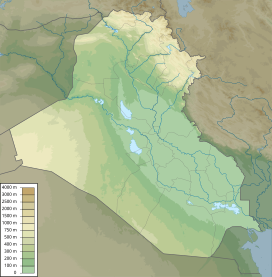
Back جبل سنجار Arabic ܛܘܪ ܫܝܓܪ ARC جبل سنجار ARZ Jebel Sinjar AST Jabal Sinjar Catalan چیای شنگال CKB Sindžár (pohoří) Czech Dschabal Sindschar German Koyê Sincari DIQ Jebel Sinjar Spanish
| Sinjar | |
|---|---|
 Terrace farming on Sinjar mountains | |
| Highest point | |
| Elevation | 1,463 m (4,800 ft) |
| Coordinates | 36°22′0.22″N 41°43′18.62″E / 36.3667278°N 41.7218389°E |
| Geography | |
The Sinjar Mountains[1][2] (Kurdish: چیایێ شنگالێ, romanized: Çiyayê Şingalê, Arabic: جَبَل سِنْجَار, romanized: Jabal Sinjār, Syriac: ܛܘܪܐ ܕܫܝܓܪ, romanized: Ṭura d'Shingar),[3] are a 100-kilometre-long (62 mi) mountain range that runs east to west, rising above the surrounding alluvial steppe plains in northwestern Iraq to an elevation of 1,463 meters (4,800 ft). The highest segment of these mountains, about 75 km (47 mi) long, lies in the Nineveh Governorate. The western and lower segment of these mountains lies in Syria and is about 25 km (16 mi) long. The city of Sinjar is just south of the range.[4][5] These mountains are regarded as sacred by the Yazidis.[6][7]
- ^ Jabal Sinjār (Approved) at GEOnet Names Server, United States National Geospatial-Intelligence Agency
- ^ جبل سنجار (Native Script) at GEOnet Names Server, United States National Geospatial-Intelligence Agency
- ^ Thomas A. Carlson, “Mount Sinjar — ܛܘܪܐ ܕܫܝܓܪ ” in The Syriac Gazetteer last modified June 30, 2014, http://syriaca.org/place/524.
- ^ Edgell, H. S. 2006. Arabian Deserts: Nature, Origin, and Evolution. Springer, Dordrecht, The Netherlands. 592 pp. ISBN 978-1-4020-3969-0
- ^ Numan, N. M. S., and N. K. AI-Azzawi. 2002. Progressive Versus Paroxysmal Alpine Folding in Sinjar Anticline Northwestern Iraq. Iraqi Journal of Earth Science. vol. 2, no.2, pp.59-69.
- ^ Phillips, David L. (7 October 2013). "Iraqi Kurds: "No Friend but the Mountains"". Huffington Post.
- ^ By Rudaw. "ISIS resumes attacks on Yezidis in Shingal". Rudaw.
